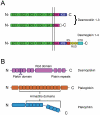Structure, function, and regulation of desmosomes
- PMID: 23481192
- PMCID: PMC4336551
- DOI: 10.1016/B978-0-12-394311-8.00005-4
Structure, function, and regulation of desmosomes
Abstract
Desmosomes are adhesive intercellular junctions that mechanically integrate adjacent cells by coupling adhesive interactions mediated by desmosomal cadherins to the intermediate filament cytoskeletal network. Desmosomal cadherins are connected to intermediate filaments by densely clustered cytoplasmic plaque proteins comprising members of the armadillo gene family, including plakoglobin and plakophilins, and members of the plakin family of cytolinkers, such as desmoplakin. The importance of desmosomes in tissue integrity is highlighted by human diseases caused by mutations in desmosomal genes, autoantibody attack of desmosomal cadherins, and bacterial toxins that selectively target desmosomal cadherins. In addition to reviewing the well-known roles of desmosomal proteins in tissue integrity, this chapter also highlights the growing appreciation for how desmosomal proteins are integrated with cell signaling pathways to contribute to vertebrate tissue organization and differentiation.
Copyright © 2013 Elsevier Inc. All rights reserved.
Figures


References
Publication types
MeSH terms
Substances
Grants and funding
LinkOut - more resources
Full Text Sources
Other Literature Sources
Molecular Biology Databases

